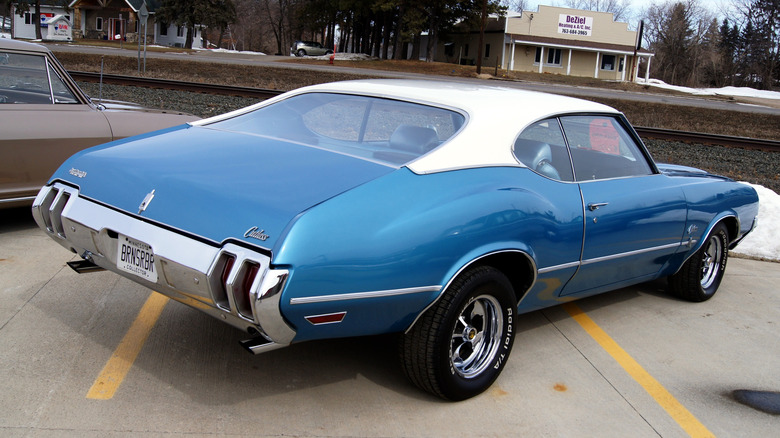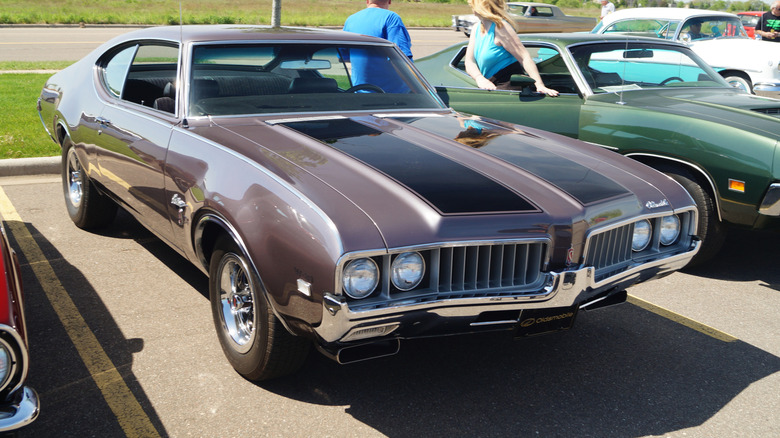Why The Oldsmobile Ram Rod 350 Was Such A Special Engine
The muscle era of the late-1960s is often seen as one of automotive history's golden ages. A diverse array of famous and innovative designs, powertrains, and models all came out in the span of less than a decade.
For example, the 1960s saw the formation of the Pony Car, the rise of SCCA circuit racing, drag racing, and the explosive popularity of NASCAR stock car racing; and a host of gorgeous and powerful machines for the road. Among the many manufacturers throwing their hats into the ring sat Oldsmobile, a company known for creating legendary vehicles such as the 442 (pronounced four four two), Cutlass, and Toronado, among several others.
Every manufacturer typically had their own ways of differentiating the best from the rest, such as the GT for Ford, the SS for Chevrolet, and the R/T for Dodge. Oldsmobile's variant of this was the W-package, a designation given to a performance-oriented option checked off on the order form.
W-series engines ranged from mild to wild, and the Ram Rod 350 sat comfortably in the middle. Its 5.7-liter displacement naturally didn't put out as much power as the likes of the 455, which went up to 400 horsepower in the Toronado, making it the single most powerful Olds ever produced for public consumption. By contrast, the W-31 Ram Rod 350, as it was known, only put out 325 horsepower — granted, it's 325 horsepower from a small block, which is an impressive feat for 1968. Let's take a look under the hood and see why this engine was developed and what makes it unique.
Why the Ram Rod 350 existed
Classic Oldsmobiles are typically well regarded for their big blocks with mountains of torque and outstanding long-range performance, leaving the 350 as something of an enigma under the hood. That's not to mention that Oldsmobile didn't really produce anything smaller than a Cutlass in those days.
You had the Chevrolet Nova and Camaro in the compact and pony classes, respectively, but Oldsmobile specialized in larger, more luxury-oriented vehicles — with the exception of high-output big blocks like the classic 442, a name associated with performance throughout the 1960s and beyond. What use, then, was a high-performance small block?
It was actually a cost-saving measure, but not specifically on the part of Oldsmobile, but rather those who purchased them. Oldsmobile marketed W-equipped models as Junior Super Cars, affordable options for people looking to get into muscle cars, but want to save money on the hefty insurance premiums associated with big blocks and big names.
By contrast, a W-31 F85 coupe was less powerful, but it saved over $400 compared to the larger W-30 equipped 442. It might not've been particularly fast, but that doesn't matter so much when you can option up a cheap daily driver to do some respectable quarter-mile times.
Oldsmobile first produced these engines in 1968, boasting a number of racing-inspired improvements, such as a hotter camshaft and improved valvetrain. Coupled with a four-speed manual, and suddenly you have a car with the feel of a typical mid-size luxury sedan, and the performance of a mid-tier Camaro.
What vehicles used the W-31 package?
Being a small block V8, the W-31 Ram Rod 350 generally appeared in the mid-size vehicles in Oldsmobile's lineup, including the F-85 and various Cutlass models. It didn't sell particularly well, however, with 742 examples shifted in 1968, 913 in 1969, and 1,352 in 1970. Bear in mind that these were the glory years of the muscle car, several years prior to the introduction of choking emissions restrictions that severely handicapped big block engines across the board.
Moreover, it wasn't the only small block V8 produced by Oldsmobile, nor even the only 350; for instance, you have the Rallye 350 of 1970 offered on the Cutlass and F85, which was distinctly marketed from the W-31 of that same year, and is also one of the most underappreciated Oldsmobile muscle cars.
Overall, it wasn't specifically the engine's fault, more so that Oldsmobile placed many of its eggs into the big block basket with cars like the special-edition Hurst Olds and the 442. Small blocks, by comparison, filled a niche which wasn't a big deal, until 1973 when the Oil Crisis hit, and nobody had a crystal ball powerful enough to see that coming.
However, the engine itself was a perfectly serviceable V8, and it was fast enough to at least hang with the big boys, if not directly compete with them. Moreover, it was an oddity for Oldsmobile, a company that rarely produced any high-revving V8 in general, much less a performance-oriented small block, making the W31 both rare and desirable today.


